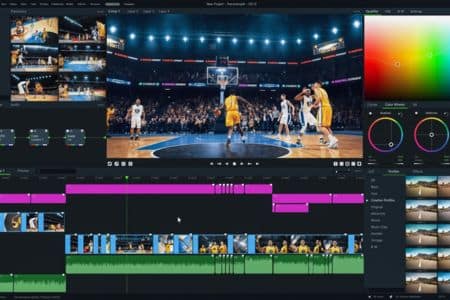
Sports are more than just games—they’re about energy, stories, and connection. Today, most of that connection comes through sports video production. From last-second scores and team entrances to pre-game rituals and interviews, video brings fans closer to the action. Whether it’s through social media, livestreams, or national broadcasts, producing content has become one of the most essential ways sports teams and leagues engage their audiences.
As the demand for producing content grows, so does the need for skilled video professionals. Teams in professional sports, college athletics, high schools, and even youth leagues are all looking for people who can film, edit, and help create compelling content.
If you’re interested in sports, technology, and storytelling, a career in sports video production might be right for you.
How to Break Into Sports Video Production
If you want to get into sports production video, the good news is that there are many entry points. Whether you’re from a background in media, sports, or are completely self-taught, there’s room to grow if you’re willing to put in the work.
Sports teams and production companies are always looking for people who can create explicit, exciting, and professional content, and many started with just a camera, some editing software, and a passion for sports.
Step 1 – Learn the Tools and Skills
Before applying for any job, you need to understand the tools used in content production. Learning to operate a camera is essential, especially when filming live sports. Fast motion, unpredictable plays, and low lighting make sports different from other types of filming.
You must also be familiar with editing software such as Adobe Premiere Pro, Final Cut Pro, or DaVinci Resolve. These programs let you clean up footage, add graphics, and cut together clean, exciting highlights.
Good video work also requires attention to detail. Small things, such as audio syncing, clip timing, and framing shots, can make or break a video. And beyond technical skills, you should understand how a game flows. The best videographers don’t just point the camera—they anticipate moments and help tell the whole story of a sports event.
Step 2 – Build a Portfolio
In this field, your portfolio speaks louder than your résumé. Employers want to see what you can do. That’s why it’s essential to start filming games and building a collection of sample projects. Offer to film high school games or volunteer with a college team.
Even if you’re not working with professional sports teams, any footage you shoot helps you improve and gives you material to show.
Once you’ve collected strong clips, edit them into a short demo reel. Keep it focused and clear. The first 30 seconds should show your best work, especially if you apply to a production company or a sports team. Share this reel online and include it whenever you apply for jobs.
Strong examples of your work will help you stand out and get noticed.
Step 3 – Gain Real-World Experience
Classroom learning and tutorials are helpful, but the real learning starts when you’re in the field. Filming a live sports event teaches you to react quickly, manage your equipment under pressure, and stay focused for long periods. Working with a real team also shows you how sports departments operate behind the scenes.
Start by volunteering with school teams, helping local clubs, or applying for sports video production internships at media companies or college athletic departments. Some production companies also look for entry-level assistants or camera operators.
This kind of work teaches you how to handle equipment, stay organized, and meet deadlines, which are all critical for building trust in a fast-paced industry.
Step 4 – Network in the Sports Video Industry
Many people get their first job through someone they met. Networking is a key part of working in sports video. Start by connecting with other creators online.
You can join social media groups, follow sports video professionals, and participate in video or sports-related forums. Ask questions, share your work, and be active in conversations.
Attend industry events, such as the NAB Show or a Sports Video Group conference, if possible. These events often feature talks from people working in the field and offer chances to meet companies hiring for video roles. Sometimes, all it takes is one introduction to get your next opportunity.
Step 5 – Apply for Sports Video Jobs Strategically
There are many places to look for sports video jobs, but how you apply matters. Don’t send the same résumé everywhere. Instead, read each job post and adjust your application to match their requirements. Please include links to your demo reel and explain why you’re a good fit based on what they’re looking for.
You can find job listings on JobsInSports and LinkedIn. Some college and pro team websites also post job openings directly.
Whether you want to work in live sports coverage, social media content, or longer video features, showing that you understand the role and can meet its needs will help you land interviews.
Sports Video Production Jobs: Career Options

Sports video production encompasses a diverse range of jobs, tailored to your strengths and interests. Some people love being at the game with a camera. Others prefer the editing room or managing a team of creators. Here are some of the most common roles.
Sports Videographer
A sports videographer usually films the action. They attend games, practices, interviews, and other team events. Videographers need to be comfortable on their feet, work long hours, and move quickly to capture important moments. They often travel with teams and work closely with coaches and marketing staff.
This job is ideal for individuals who want to be in the field and enjoy working in a fast-paced environment. It also requires strong attention to detail and a steady hand during high-pressure moments.
Sports Video Editor Jobs
Sports video editors take raw footage and turn it into finished pieces. These could be highlight reels, team promos, or player features. Editors work behind the scenes and must be fast, creative, and organized. A typical day might involve editing several clips on deadline and adjusting them for various platforms, such as TikTok, Instagram, or stadium screens.
Editors also need to understand brand style. Teams often have rules about colors, logos, and music. Editors must follow those rules while still producing exciting and fresh content, making attention to detail a crucial skill for anyone pursuing sports video editor jobs in today’s competitive market.
Sports Video Producer
Producers are planners and team leaders. They develop content ideas, assign work to videographers or editors, and ensure projects stay on schedule. They may also work with sponsors, marketing teams, and athletes. Producers handle both the creative and business sides of video.
Sports Video Producers often manage day-to-day operations at a sports media company or assist teams in organizing their video schedules.
This job is perfect for someone with experience in both shooting and editing and who enjoys big-picture thinking.
Freelance and Contract Work
Not all jobs in this field are full-time. Many people work as freelancers or on a contract basis. A team might hire someone for a single sports event or a short video series. This kind of work is common for social media content, livestreaming help, or player highlights.
Freelance work gives you flexibility and can help you build experience quickly. But it also means you have to find your own clients, manage your time well, and keep your gear ready at all times.
Top Sports Video Production Companies to Watch
If you want to know where the jobs are, it helps to follow the video production companies doing top work in the sports industry. Big names in sports like ESPN, NFL Films, Bleacher Report, and MLB Network are always looking for talent. These companies produce content for millions of fans and cover everything from live games to short-form documentaries.
Newer media brands, such as Overtime and Whistle Sports, focus on younger audiences and often hire creators for social-first content. These companies might be smaller than the major networks, but they offer fast-paced environments and fresh ideas for producing content.
Many production companies also work directly with teams, leagues, or athlete brands. Some focus on livestreaming, others on creating player reels or behind-the-scenes coverage. Following these companies online is a good way to stay updated on trends and job openings.
Common Mistakes to Avoid in Sports Video Careers
Breaking into this field takes skill, persistence, and professionalism. Avoid these common mistakes that can hold you back:
- Low-quality demo reels – A reel is often your first impression. If it has poor audio, shaky footage, bad lighting, or rushed editing, it can turn off potential employers. Invest time in choosing strong clips, stabilizing your footage, and using clean transitions. Even if your gear isn’t top-tier, your attention to detail and effort should still shine through.
- No storytelling – A reel full of random highlights may show your technical skills, but it won’t leave a lasting impact. A great sports video tells a story, showing the buildup, the climax (the big play), and even the emotional reaction that follows. Whether it’s a game-winning shot or a heartfelt coach speech, structure matters. Make the viewer feel something.
- Lack of examples – Some applicants skip submitting actual work, relying only on resumes or promises. That’s a red flag for hiring teams. Even if you’re just starting, shoot footage at local games or practices and edit a couple of short features. A few well-done clips are better than nothing at all and show you’re serious about the craft.
- Missing deadlines – In this industry, timing is everything. Highlights are often needed within hours of a game ending. If you struggle with time management, miss delivery dates, or fail to follow submission guidelines, it can quickly damage your reputation. Consistently meeting deadlines demonstrates that you are reliable and prepared for the fast-paced world of sports media.
- Not understanding the sport – You don’t need to be a former athlete, but knowing the rules, pace, and key moments of a sport helps you anticipate what to film or emphasize in editing. If you miss the game-winning goal or cut away during a crucial moment, your content loses impact. Watching games, studying player tendencies, and staying informed can help you capture the right footage at the right time.
Tools and Resources to Get Started
Here’s a basic starter kit for new creators:
Gear:
- Mirrorless or DSLR camera
- Tripod
- Lavalier or shotgun mic
- Backup batteries and memory cards
Software:
- Adobe Premiere Pro
- Final Cut Pro
- DaVinci Resolve (has a free version)
Learning Platforms:
- Coursera
- LinkedIn Learning
- YouTube channels for editing and sports filming tips
Communities:
- Sports Video Group (SVG)
- Online videographer forums and Discords
- Reddit groups like r/videography
Using the right tools and staying connected to others helps you keep improving your skills and finding new opportunities.
Let JobsInSports Help You Find Sports Video Production Jobs

Finding your first or next job in this field can take time, but the right tools and support make a difference. JobsInSports is a leading website for people looking to work in professional sports and athletics. You can search for sports video production jobs, set up job alerts, and find tips to help with your applications.
Whether you’re aiming for a career in content production, live broadcasting, or social media video, JobsInSports.com can connect you to the right opportunities.
Creating a profile and uploading your demo reel increases your chances of being noticed by hiring teams.





